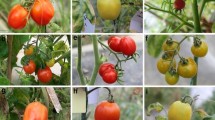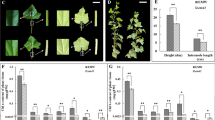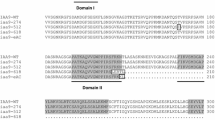Abstract
Chili peppers are important as vegetables and ornamental crops, because of the variety of fruit shapes and colors. Understanding of flower and fruit development in Capsicum is limited compared with closely related Solanaceae crops such as tomato. This study reports a novel malformed fruit mutant named malformed fruit-1 (maf-1), which was isolated from an ethyl methanesulfonate–induced mutant population of chili pepper. maf-1 exhibited homeotic changes in the floral bud, which were characterized by conversion of petals and stamens into sepal-like and carpel-like organs, respectively. In addition, the indeterminate formation of carpel-like tissue was observed. Genetic analysis demonstrated that the causative gene in maf-1 is a nonsense mutation in CaLFY. This is the first characterization of an lfy mutant in Capsicum. Unlike tomatoes, the CaLFY mutation did not affect the architecture of sympodial unit or flowering time but mainly affected the formation of flower organs. Gene expression analysis suggested that a nonsense mutation in CaLFY led to decreased expression of multiple class B genes, resulting in homeotic changes in the flower and fruit. This maf-1 mutant may provide new insights at the molecular level in understanding flower organ formation and the genetic manipulation of fruit shape in chili peppers.







Similar content being viewed by others
Data availability
Relevant data are included in this paper and its associated Supplementary Information.
References
Ampomah-Dwamena C, Morris BA, Sutherland P, Veit B, Yao JL (2002) Down-regulation of TM29, a tomato SEPALLATA homolog, causes parthenocarpic fruit development and floral reversion. Plant Physiol 130:605–617
Borovsky Y, Sharma VK, Verbakel H, Paran I (2015) CaAP2 transcription factor is a candidate gene for a flowering repressor and a candidate for controlling natural variation of flowering time in Capsicum annuum. Theor Appl Genet 128:1073–1082
Bosland PW, Votava EJ (2000) Peppers: vegetable and spice capsicums. CABI Publishing, New York
Busi MV, Bustamante C, D’Angelo C, Hidalgo-Cuevas M, Boggio SB, Valle EM, Zabaleta E (2003) MADS-box genes expressed during tomato seed and fruit development. Plant Mol Biol 52:801–815
Chung E, Seong E, Kim YC, Chung EJ, Oh S-K, Lee S, Park JM, Jung H, Choi D (2004) A method of high frequency virus-induced gene silencing in chili pepper (Capsicum annuum L. cv. Bukang). Mol Cells 17:377–380
Coen ES, Meyerowitz EM (1991) The war of the whorls: genetic interactions controlling flower development. Nature 353:31–37
Cohen O, Borovsky Y, David-Schwartz R, Paran I (2012) CaJOINTLESS is a MADS-box gene involved in suppression of vegetative growth in all shoot meristems in pepper. J Exp Bot 63:4947–4957
Cohen O, Borovsky Y, David-Schwartz R, Paran I (2014) Capsicum annuum S (CaS) promotes reproductive transition and is required for flower formation in pepper (Capsicum annuum). New Phytol 202:1014–1023
de Martino G, Pana I, Emmanuel E, Levy A, Vivian F, Irish VF (2006) Functional analyses of two tomato APETALA3 genes demonstrate diversification in their roles in regulating floral development. Plant Cell 18:1833–1845
Denay G, Chahtane H, Tichtinsky G, Parcy F (2017) A flower is born: an update on Arabidopsis floral meristem formation. Curr Opin Plant Biol 35:15–22
DePristo MA, Banks E, Poplin R, Garimella KV, Maguire JR, Hartl C, Philippakis AA et al (2011) A framework for variation discovery and genotyping using next-generation DNA sequencing data. Nat Genet 43:491–498
Elitzur T, Nahum H, Borovsky Y, Pekker I, Eshed Y, Paran I (2009) Co-ordinated regulation of flowering time, plant architecture and growth by FASCICULATE: the pepper orthologue of SELF PRUNING. J Exp Bot 60:869–880
Geuten K, Irish V (2010) Hidden variability of floral homeotic B genes in Solanaceae provides a molecular basis for the evolution of novel functions. Plant Cell 22:2562–2578
Gimenez E, Castañeda L, Pineda B, Pan IL, Moreno V, Angosto T et al (2016) TOMATO AGAMOUS1 and ARLEQUIN/TOMATO AGAMOUS-LIKE1 MADS-box genes have redundant and divergent functions required for tomato reproductive development. Plant Mol Biol 91:513–531
Gómez P, Jamilena M, Capel J, Zurita S, Angosto T, Lozano R (1999) Stamenless, a tomato mutant with homeotic conversions in petals and stamens. Planta 209:172–179
Hamès C, Ptchelkine D, Grimm C, Thevenon E, Moyroud E, Gérard F, Martiel JL, Benlloch R, Parcy F, Müller CW (2008) Structural basis for LEAFY floral switch function and similarity with helix-turn-helix proteins. EMBO J 27:2628–2637
Hofer J, Turner L, Hellens R, Ambrose M, Matthews P, Michael A, Ellis N (1997) UNIFOLIATA regulates leaf and flower morphogenesis in pea. Curr Biol 7:581–587
Jeifetz D, David-Schwartz R, Borovsky Y, Paran I (2011) CaBLIND regulates axillary meristem initiation and transition to flowering in pepper. Planta 234:1227–1236
Kato K, Ohta K, Komata Y, Araki T, Kanahama K, Kanayama Y (2005) Morphological and molecular analyses of the tomato floral mutant leafy in florescence, a new allele of falsiflora. Plant Sci 169:131–138
Kim DH, Han MS, Cho HW, Kim DS, Kim HJ, Kim BD (2008) Molecular cloning of the CaLFY, putative pepper ortholog of FLO/LFY. Mol Breed 22:443–453
Kim S, Park M, Yeom SI, Kim YM, Lee JM, Lee HA, Seo E et al (2014) Genome sequence of the hot pepper provides insights into the evolution of pungency in Capsicum species. Nat Genet 46:270–278
Kim J, Park M, Jeong ES, Lee JM, Choi D (2017) Harnessing anthocyanin-rich fruit: a visible reporter for tracing virus-induced gene silencing in pepper fruit. Plant Methods 13:3
Kramer EM, Dorit RL, Irish VF (1998) Molecular evolution of petal and stamen development, gene duplication and divergence within the APETALA3 and PISTILLATA MADS-box gene lineages. Genetics 149:765–783
Lamb RS, Hill TA, Tan QK, Irish VF (2002) Regulation of APETALA3 floral homeotic gene expression by meristem identity genes. Development 129:2079–2086
Lenhard M, Bohnert A, Jurgens G, Laux T (2001) Termination of stem cell maintenance in Arabidopsis floral meristems by interactions between WUSCHEL and AGAMOUS. Cell 105:805–814
Li H, Durbin R (2010) Fast and accurate long-read alignment with Burrows-Wheeler transform. Bioinformatics 26:589–595
Lippman ZB, Cohen O, Alvarez JP, Abu-Abied M, Pekker I, Paran I, Eshed Y, Zamir D (2008) The making of a compound inflorescence in tomato and related nightshades. PLoS Biol 6:e288
Lohmann JU, Weigel D (2002) Building beauty: the genetic control of floral patterning. Dev Cell 2:135–142
Lohmann JU, Hong RL, Hobe M, Busch MA, Parcy F, Simon R, Weigel D (2001) A molecular link between stem cell regulation and floral patterning in Arabidopsis. Cell 105:793–803
Lozano R, Gimenez E, Cara B, Capel J, Angosto T (2009) Genetic analysis of reproductive development in tomato. Int J Dev Biol 53:8–10
Mazzucato A, Olimpieri I, Siligato F, Picarella ME, Soressi GP (2008) Characterization of genes controlling stamen identity and development in a parthenocarpic tomato mutant indicates a role for the DEFICIENS ortholog in the control of fruit set. Physiol Plant 132:526–537
Molinero-Rosales N, Jamilena M, Zurita S, Gomez P, Capel J, Lozano R (1999) FALSIFLORA, the tomato orthologue of FLORICAULA and LEAFY, controls flowering time and floral meristem identity. Plant J 20:685–693
Ó’Maoiléidigh DS, Graciet E, Wellmer F (2014) Gene networks controlling Arabidopsis thaliana flower development. New Phytol 201:16–30
Pajoro A, Biewers S, Dougali E, Leal Valentim F, Mendes MA, Porri A et al (2014) The (r)evolution of gene regulatory networks controlling Arabidopsis plant reproduction: a two-decade history. J Exp Bot 65:4731–4745
Pelaz S, Tapia-Lopez R, Alvarez-Buylla ER, Yanofsky MF (2001) Conversion of leaves into petals in Arabidopsis. Curr Biol 11:182–184
Pnueli L, Abu-Abeid M, Zamir D, Nacken W, Schwarzsommer Z, Lifschitz E (1991) The MADS box gene family in tomato: temporal expression during floral development, conserved secondary structures and homology with homeotic genes from Antirrhinum and Arabidopsis. Plant J 1:255–266
Pnueli L, Hareven D, Rounsley SD, Yanofsky MF (1994a) Isolation of the tomato AGAMOUS gene TAG1 and analysis of its homeotic role in transgenic plants. Plant Cell 6:163–173
Pnueli L, Hareven D, Broday L, Hurwitz C (1994b) The TM5 MADS box gene mediates organ differentiation in the three inner whorls of tomato flowers. Plant Cell 6:175–186
Quinet M, Bataille G, Dobrev PI, Capel C, Gomez P, Capel J, Lutts S, Motyka V, Angosto T, Lozano R (2014) Transcriptional and hormonal regulation of petal and stamen development by STAMENLESS, the tomato (Solanum lycopersicum L.) orthologue to the B-class APETALA3 gene. J Exp Bot 65:2243–2256
Quinet M, Angosto T, Yuste-Lisbona FJ, Blanchard-Gros R, Bigot S, Martinez JP, Lutts S (2019) Tomato fruit development and metabolism. Front Plant Sci 10:1554
Siriwardana NS, Lamb RS (2012a) The poetry of reproduction: the role of LEAFY in Arabidopsis thaliana flower formation. Int J Dev Biol 56:207–221
Siriwardana NS, Lamb RS (2012b) A conserved domain in the N-terminus is important for LEAFY dimerization and function in Arabidopsis thaliana. Plant J 71:736–749
Souer E, van der Krol A, Kloos D, Spelt C, Bliek M, Mol J, Koes R (1998) Genetic control of branching pattern and floral identity during Petunia inflorescence development. Development 125:733–742
Sundström JF, Nakayama N, Glimelius K, Irish VF (2006) Direct regulation of the floral homeotic APETALA1 gene by APETALA3 and PISTILLATA in Arabidopsis. Plant J 46:593–600
Takagi H, Abe A, Yoshida K, Kosugi S, Natsume S, Mitsuoka C et al (2013) QTL-seq: rapid mapping of quantitative trait loci in rice by whole genome resequencing of DNA from two bulked populations. Plant J 74:174–183
Tanaka Y, Mitani A, Shimizu N, Goto T, Yoshida Y, Yasuba K (2021) Characterization and bulk segregant analysis of a novel seedless mutant tn-1 of chili pepper (Capsicum annuum). Sci Hortic 276:109729
Thomson B, Wellmer F (2019) Molecular regulation of flower development. Curr Top Dev Biol 131:185–210
Viaene T, Vekemans D, Irish VF, Geeraerts A, Huysmans S, Janssens S, Smets E, Geuten K (2009) Pistillata—duplications as a mode for floral diversification in (basal) Asterids. Mol Biol Evol 26:2627–2645
Vrebalov J, Ruezinsky D, Padmanabhan V, White R, Medrano D, Drake R, Schuch W, Giovannoni J (2002) A MADS-box gene necessary for fruit ripening at the tomato ripening-inhibitor (rin) locus. Science 296:343–346
Weigel D, Alvarez J, Smyth DR, Yanofsky MF, Meyerowitz EM (1992) LEAFY controls floral meristem identity in Arabidopsis. Cell 69:843–859
Winter CM, Austin RS, Blanvillain-Baufume S, Reback MA, Monniaux M, Wu MF, Sang Y, Yamaguchi A, Yamaguchi N, Parker JE et al (2011) LEAFY target genes reveal floral regulatory logic, cis motifs, and a link to biotic stimulus response. Dev Cell 20:430–443
Zhou YJ, Deng YT, Liu D, Wang HZ, Zhang X, Liu TT et al (2021) Promoting virus-induced gene silencing of pepper genes by a heterologous viral silencing suppressor. Plant Biotechnol J 19:2398–2400
Acknowledgements
Computations were partially performed on the NIG supercomputer at ROIS National Institute of Genetics.
Funding
This study was supported in part by a Grant-in-Aid for Scientific Research (B) (21H02187).
Author information
Authors and Affiliations
Contributions
YT designed the research, conducted the mapping-by-sequencing analysis, and wrote the manuscript. MY conducted the genetic analysis and gene expression analyses. NG conducted the anatomical analyses. TG, YY, and KY assisted with the cultivation and screening of the maf-1 mutant. SO and MD interpreted the results of the genetic and expression analyses. All authors read and approved the final manuscript.
Corresponding author
Ethics declarations
Ethics approval and consent to participate
Not applicable.
Consent for publication
Not applicable.
Competing interests
The authors declare no competing interests.
Additional information
Publisher’s note
Springer Nature remains neutral with regard to jurisdictional claims in published maps and institutional affiliations.
Supplementary Information
Below is the link to the electronic supplementary material.
Rights and permissions
About this article
Cite this article
Tanaka, Y., Yokota, M., Goto, N. et al. Morphological and gene expression characterization of maf-1, a floral chili pepper mutant caused by a nonsense mutation in CaLFY. Mol Breeding 42, 32 (2022). https://doi.org/10.1007/s11032-022-01304-w
Received:
Accepted:
Published:
DOI: https://doi.org/10.1007/s11032-022-01304-w




